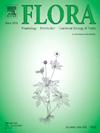Anatomical adaptations of plants within the Southern Brazil coastal sand dunes
IF 1.7
4区 生物学
Q3 ECOLOGY
引用次数: 0
Abstract
Coastal ecosystems play a crucial role in preserving biodiversity and providing essential ecosystem services to society. Among these ecosystems, coastal dunes and Restinga vegetation stand out for their uniqueness and the diversity of species adapted to extreme environmental conditions. This study aims to investigate the adaptations of plants in these ecosystems, with a specific focus on leaf anatomy, to deepen our understanding of the adaptive strategies adopted by these species and to provide an overview of the most common strategies. To achieve this, we analyzed leaves from 47 prevalent species in herbaceous Restinga of Southern Brazil, across four different microhabitat conditions, employing microscopic techniques to address both qualitative and quantitative measurements to evaluate anatomical characteristics. The results yielded insights into the diversity of plant adaptations to different microhabitats. Key findings include the presence of thickened external periclinal walls, the height of epidermal cells, and a predominance of amphistomatous leaves. These characteristics suggest adaptations to minimize water loss through transpiration due to solar radiation protection against damage of radiation, and a better use of the light that arrives from all directions, reflected by the sand. Additionally, specialized water storage tissues such as the hydrenchyma, voluminous epidermal cells, and hypodermis were identified, indicating adaptations to environments with water restriction and high temperatures. Our data contribute to a better understanding of the adaptive strategies of plants in coastal ecosystems, providing insights for more specialized research approaches and the implementation of practical conservation and management measures in these ecosystems.
巴西南部海岸沙丘内植物的解剖适应性
沿海生态系统在保护生物多样性和为社会提供必要的生态系统服务方面发挥着至关重要的作用。在这些生态系统中,海岸沙丘和雷斯廷加植被以其独特性和适应极端环境条件的物种多样性而脱颖而出。本研究旨在探讨植物在这些生态系统中的适应性,特别关注叶片解剖,以加深我们对这些物种采用的适应策略的理解,并提供最常见策略的概述。为了实现这一目标,我们分析了巴西南部草本Restinga中47种常见物种的叶片,在四种不同的微栖息地条件下,采用显微技术进行定性和定量测量,以评估解剖特征。研究结果揭示了植物适应不同微生境的多样性。主要发现包括外周壁增厚,表皮细胞高度增高,双气孔叶占优势。这些特征表明,由于太阳辐射、防止辐射损害、更好地利用来自四面八方、被沙子反射的光,这些适应措施可以最大限度地减少由于蒸腾作用而造成的水分损失。此外,还发现了特殊的储水组织,如水组织、大体积表皮细胞和皮下组织,表明它们适应了水分限制和高温的环境。我们的数据有助于更好地理解沿海生态系统中植物的适应策略,为更专业的研究方法和在这些生态系统中实施实际的保护和管理措施提供见解。
本文章由计算机程序翻译,如有差异,请以英文原文为准。
求助全文
约1分钟内获得全文
求助全文
来源期刊

Flora
生物-植物科学
CiteScore
3.30
自引率
10.50%
发文量
130
审稿时长
54 days
期刊介绍:
FLORA publishes original contributions and review articles on plant structure (morphology and anatomy), plant distribution (incl. phylogeography) and plant functional ecology (ecophysiology, population ecology and population genetics, organismic interactions, community ecology, ecosystem ecology). Manuscripts (both original and review articles) on a single topic can be compiled in Special Issues, for which suggestions are welcome.
FLORA, the scientific botanical journal with the longest uninterrupted publication sequence (since 1818), considers manuscripts in the above areas which appeal a broad scientific and international readership. Manuscripts focused on floristics and vegetation science will only be considered if they exceed the pure descriptive approach and have relevance for interpreting plant morphology, distribution or ecology. Manuscripts whose content is restricted to purely systematic and nomenclature matters, to geobotanical aspects of only local interest, to pure applications in agri-, horti- or silviculture and pharmacology, and experimental studies dealing exclusively with investigations at the cellular and subcellular level will not be accepted. Manuscripts dealing with comparative and evolutionary aspects of morphology, anatomy and development are welcome.
 求助内容:
求助内容: 应助结果提醒方式:
应助结果提醒方式:


